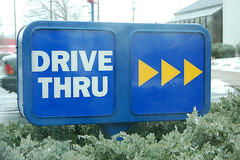The drive-to-lunch syndrome

Posted October 27, 2008 at 2:04PM
One of the main differences between a walkable, amenity-rich environment such as the one being created for San Mateo's Station Park Green and automobile-dependent sprawl is that, in the latter, workers have to drive to lunch unless they bring it in from home.  This can be the case even when a place to eat is within what would be walking distance if the roadways, parking lots and entrances were not configured in a way that is dangerous or not welcoming to pedestrians.
This can be the case even when a place to eat is within what would be walking distance if the roadways, parking lots and entrances were not configured in a way that is dangerous or not welcoming to pedestrians.
My friend Constance Beaumont used to have a couple of slides in her presentation that showed two suburban retail stores right next to each other, but separated by a chain-link fence that precluded walking from one to the other.
The result is not only inconvenience for customers and hungry office workers but also extra air pollution, greenhouse gas emissions, and traffic congestion. Constance's photos were taken, naturally, in Tysons Corner, Virginia, subject of previous blog entries. Part of me resists picking on Tysons so much because it is such an easy target, and because at least Fairfax County's planners are doing something about it.
 But, meanwhile, an easy target it remains. Writing in The Washington Post, Eric Weiss reports that "so many workers drive to lunch in Tysons Corner that it has created a third rush hour during the middle of the day that actually exceeds the morning rush.." Weiss continues:
But, meanwhile, an easy target it remains. Writing in The Washington Post, Eric Weiss reports that "so many workers drive to lunch in Tysons Corner that it has created a third rush hour during the middle of the day that actually exceeds the morning rush.." Weiss continues:
"Having so many of the approximately 115,000 Tysons workers on the road, often driving less than a mile to grab a sandwich, is complicating construction plans for a Metrorail extension and Capital Beltway toll lanes that will rip up the streets around the area. An analysis of traffic counts shows more than 23,000 vehicles on the major Tysons thoroughfares, routes 7 and 123, between 11:30 a.m. and 2 p.m., surpassing the morning rush by 24 percent."
This, of course, is occurring despite the fact that Tysons is Virginia's most concentrated jobs and shopping hub, with literally hundreds of eating places within a short distance of its 110,000 workers.
The Post also has a graph of the amount of traffic through Tysons at various times of day, along with a nifty video of the traffic "flow" during a typical day. They are encouraging bloggers to share the video, and I am happy to oblige:
For the entire story, go here.